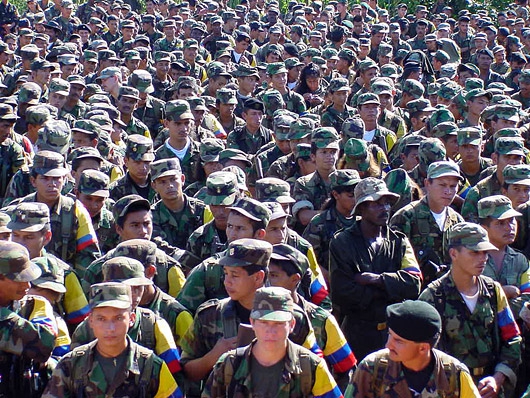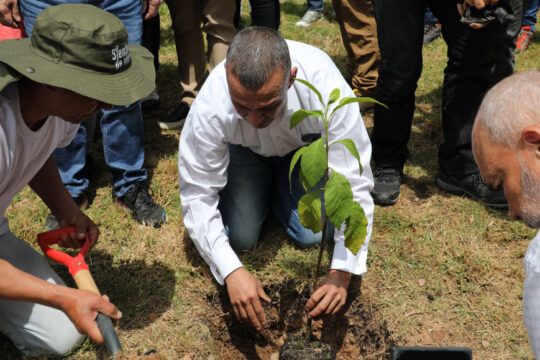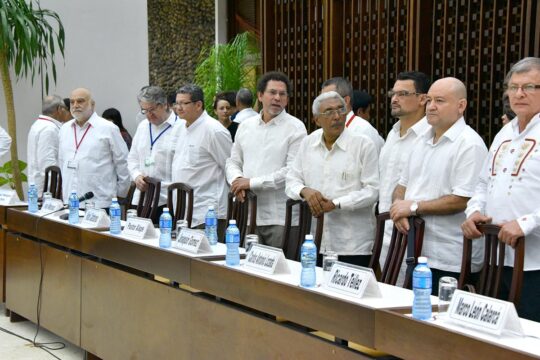For nearly six decades, the Colombian government has struggled to quell the country’s armed conflict that has left hundreds of thousands dead, millions displaced, and much of the countryside ungovernable. In June 2015, the Colombian government, under the leadership of President Juan Manuel Santos, and the Armed Revolutionary Forces of Colombia, or FARC, overcame a major hurdle in their three-year long peace negotiations.
On June 4, the two sides announced an agreement to create an impartial, independent and extrajudicial truth commission that would clarify the causes and consequences of the almost 60-year conflict. This agreement propelled the two sides to the December 2015 agreement on victims’ rights, an issue that had stalled the peace negotiations for a year and a half. In addition to clarifying that FARC rebels would be tried by special tribunals that would punish them with an “effective restriction of liberty,” the first provision of the agreement states that a Commission for Historical Clarification, Coexistence and No Repetition will be created. If the peace accords are implemented, a truth commission in Colombia is inevitable. Foreign donors, including USAID, have pledged millions of dollars towards the creation of a truth commission and other so-called transitional justice instruments.
Calls for a truth commission
These calls for a truth commission raise important questions that concerned observers, particularly those in favor of the peace process, may avoid in order to circumvent the highly divisive question of whether they support a negotiated settlement or a military solution to the longstanding insurgency. Santos’ political opponents condemn the agreement for not adequately sanctioning the rebels and have called for civil disobedience to protest the peace accords, just one example of how politicized the negotiations have become. At the same time, asking about the utility of a truth commission is crucial to avoid setting false expectations that lead to further disillusionment about the value of a negotiated settlement. Among these questions are: 1) What can a truth commission offer to a country with an almost sixty-years long conflict involving violence by guerilla groups, paramilitaries, the military, narco-traffickers, corporations, and foreign governments? 2) What can a truth commission offer to the millions of victims who have suffered egregious human rights violations, including death, disappearance, displacement, torture, rape, and ongoing political, social, and economic disenfranchisement?The agreement on a truth commission stems from the 2012 Legal Framework for Peace, which created a constitutional amendment to allow the government to create “transitional justice instruments” in its peace negotiations. This Framework provided the legal foundation for the government to negotiate a truth commission. In addition to enabling the government to selectively prosecute accused perpetrators (unless they are accused of international crimes), the Framework mandated the creation of a truth commission. Policy-makers who designed the law believed that a truth commission would be an appealing alternative to criminal proceedings, satisfying both the FARC’s concerns about facing time in prison after demobilizing, and victims’ rights to truth, justice, and reparation.To some extent, the government was correct in assuming that a truth commission would appeal to the FARC rebels. However the FARC rebels’ interests in a truth commission have more to do with their desire to avoid judicial accountability and to ensure that their version of history, which places the blame for the violence on the government, becomes the official one. In May 2015, the FARC spokesman said that a truth commission should open up the state archives, and should be an “extra-judicial mechanism of research, clarification, and punishment.” The FARC’s position was that its crimes were of a political nature and the rebels should not be jailed for their actions. Moreover, the FARC insisted that any commission investigate the role of the Colombian, as well as the US government, in fomenting the violence.
Coherent narrative
Colombia’s track record with investigative commissions suggests that a truth commission will struggle to create a coherent narrative of the violence. As of 2015, there have been twelve national investigations and three local investigations of the causes and consequences of the violence in Colombia. In 2014, the government and FARC representatives agreed to a preliminary investigation of the violence’s causes and consequences. They called this investigative body the Historical Commission on the Conflict and its Victims (HCCV). The HCCV was formed in August 2014 based on an agreement between the FARC and the government. The Commission comprised twelve researchers and two well-known writers, chosen by both the FARC and the government. In February 2015, the Commission published a lengthy volume in which each contributor provided their own perspective the causes and consequences of the violence. Given the complexity of the topic, the historians drafted very different essays, including one that offers an explanation of Colombia’s development as a nation-state and another that points out the fallacy of thinking that one can identify a beginning and end of the country’s ongoing conflicts.
While truth commission proponents discuss the value of clarifying the violence’s causes and consequences and giving victims the opportunity to share their stories, Colombians have mixed opinions on the utility of yet another initiative with these goals. In a comprehensive survey conducted by University of Los Andes political scientists, researchers asked respondents throughout Colombia about a truth commission. Interestingly, the majority of the population were unaware of the work done by the Historical Memory Center. Moreover, less than half the population said that making memory (“hacer memoria”) is necessary to recognize and respect victims, and a quarter said that “hacer memoria” would not help society advance.
Causes of the conflict
One of the most challenging issues for a future truth commission will be how to clarify the myriad causes of the ongoing conflict. A deceptively minor challenge in this endeavor has to do with how to date the conflict, but this question is fraught with political implications. The HCCV began the analysis of the conflict in 1958, the year that the FARC took up arms. This start date suggests that the violence began when the FARC took up arms, but the previous decade was the most violent in Colombia’s history. An estimated 200,000 people died from 1948-1958, compared to the estimated 220,000 killed between 1958 and 2013. The violence was known as La Violencia, and was a civil war between the Liberals and the Conservatives in which the military and paramilitaries were responsible for much of the destruction. The government has already shown its reluctance to identify its role in the violence, which has important impacts on victims. The 2011 Victim’s Law, for example, only provides indemnification for individuals who were victimized after 1985, leaving out the individuals who suffered crimes related with the conflict before that year.
The question of when to start the inquiry is an important dilemma, but it is just one of the many trade-offs that the future commissioners will have to consider as they develop and implement their mandate. There are a variety of stakeholders in the Colombian conflict, all will want their version of events to become part of the official one, and some actors wield more political power than others. This challenge is evident in the work of the Historical Memory Group, which was created in 2005 as part of the National Commission on Reparation and Reconciliation, in the context of the peace process with paramilitary groups. After the Legal Framework for Peace was passed, the Group became the Historical Memory Center. In this transition, the investigative body went from being an independent group of academics to an official government body. While the Group had focused on emblematic cases of violence and tried to bring victims’ stories into the public consciousness, the paramilitary groups and the military also demanded that their version of events be heard and acknowledged. The military argued that it should have museum dedicated to explaining their victimization in the violence, just one example among many of how each of these different groups want to ensure that they are able to shape the official narrative of violence.
Narco-traffickers
A few other challenges that any future truth commission would have to face relate to questions about domestic and international companies, narco-traffickers, and the United States’ role in perpetuating the violence through its so-called war on drugs. Victims of narco-trafficking, in particular, have been sidelined in the peace negotiations and in policies that benefit victims. Although these victims have suffered tremendously, the government worries that recognizing these victims would lead to recognition of narco-traffickers as a perpetrator group that deserves the same kinds of benefits being offered to the guerrilla and paramilitary.
Yet another problem with a truth commission has to do with the question of what role a truth commission will play in future prosecutions. Various parties hope that a truth commission will help clarify who is “most responsible” for the violence. While this commission would only clarify collective responsibility, critics of the peace negotiation insist that individuals who have committed crimes should be incarcerated. With the agreement to have special tribunals that punish the FARC with an “effective restriction of liberty,” one must wonder whether any perpetrators will face judicial sanction and, if not, what will be the outcome of clarifying who is “most responsible?” Given how politicized the peace negotiations have become, the issue of judicial sanction is likely to continue to divide those who believe in a negotiated settlement with the FARC and those who believe in a military solution to the insurgency.
In sum, given the fragility of the peace process, debates over a truth commission, much like debates over the FARC’s incarceration may leave the country more fractured than united. Victims rightfully demand truth, justice, and reparation, but ensuring these goals requires far more than the discrete interventions mandated by the Legal Framework for Peace. The various stakeholders in Colombia’s peace process may agree that a truth commission needs to be created, but agreeing to a truth commission in principle is strikingly different than agreeing to an actual body. Scholars should not shy away from pointing out the dilemmas a future truth commission will face while simultaneously celebrating the government and the FARC’s remarkable achievements towards peace in the country.





